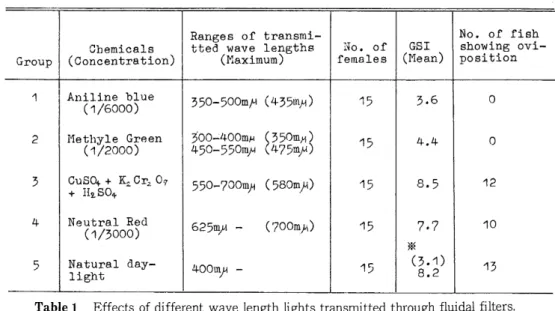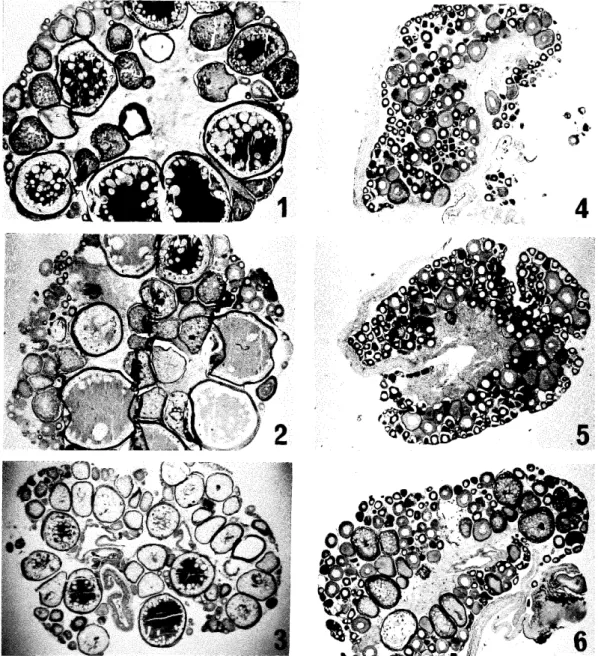メダカの生殖巣発達に作用する光の波長に関する研究(1) : 卵巣発達に及ぼす可視光の影響について
6
0
0
全文
(2) Journal of Hokkaido University of Education (Section II B) Vol. 28, No. 1 September 1977. WWHWW (H 2 ^B ) ^ 28 ^ ^ 1 ^- B§% 52 ^ 9 ^. Studies on Action Spectra of Light on Gonadal Development of the Medaka, Oryzias latipes.. 1. Effect of the Visible Light on Ovarian Development Hiroshi YOSHIOKA Biological Laboratory, Hakodate College, Hokkaido University of Education, Hakodate, 040. ^^^^^Ma^M^^fflt^^^'^.s^^t^^f^. i. m^t^^'tom^CT^'-'^-c ^ N. uMt^ffii.t^m^f^t^ Of the numerous studies in regard to the significance of light in inducing sexual maturation of fishes, a few studies were concerned with the wave length of light. The difficulties in obtaining filters suitable for the experiments and in executing the spectrum analysis of light prevented the advancement in this field of study. As the method for spectrum analysis has advanced in recent years, however, the wave length of light effective on gonadal development has been clarified by several investigators in some avian species (Farner, 1959; Ganong et al., 1963). In fishes, the work of Shiraishi(1965) on plecoglossus altivelis is the only one which concerns with the effects of the wave length light on gonadal development. Therefore, it seems impossible to draw a general conclusion on this problem. In the present paper an attempt is being made to. understand the wave length light effective in causing gonadal development of Oryzias latipes. The present writer wishes to express his gratitude to Emeritus Prof. K. Yamamoto of. Hokkaido University, for his kind advice and guidance during the course of this study. Material and Methods Adult medaka, Oryzias latipes,oi a wild type, which were collected from an irrigation pond of Yunokawa Hot Springs in the suburbs of Hakodate City, were employed for the present experiment. The experiment was carried out during the spring months of 1967. As shown in Text—Fig.. 1, 4 kinds of fluidal filters of 10 mm in thickness, made of a certain concentration of chemicals, were prepared. The transmittance of each spectrum was measured by a spectrophotometer. The percent transmission of light was constant in value for each wave length. The water temperature. of the aquaria was regulated at 14—17°C during the experiment. The fish were fed daily with freshwater oligochaetes.. (7:.
(3) H. YOSHIOKA. CuSO,+K2Cr,07+HzS04. Methyle Green y.. 50. Ani line blue 1/6000. 400. 1/2000 1/2000. 500 600 Wave length (my)-. Text—Fig. 1. Ranges of light transmitted through fluidal filters prepared with different chemicals.. Experiment and Results Sixty pairs, consisting of 30 males and 30 females, were divided into 4 groups and were kept in separate glass aquaria set in 4 boxes each prepared with a filter (Text—Fig. 2). The illumina-. tion at the surface of water ranged from 50 to 300 lux. These intensities of light were enough to stimulate the ovarian development of the medaka (Yoshioka, 1976). Light was provided by natural daylight supplemented with a 20—Watt fluorescent lamp. Another group was subjected to the natural daylight and served as a control. A long photoperiod consisting of 14 hours of light and 10 hours of darkness was employed for the present experiment. On March 22, 40 days after the. beginning of the experiment, all the fish were killed and fixed in an Alien—Bouin's solution for histological examination. Ovary weights are represented by gonadosomatic indices (GSI), the percentages of the ovary weight to the body weight. Data from the experiment are presented in Table 1. In this Table, the ovarian development of the fish of all 4 groups was divided into 2 grades according to the mean values of the. gonadosomatic index (GSI). The mean values of GSI in the fish of Group 1 was 3.6 and 4.4 in Group 2. These values were very similar to. those of initial controls. By contrast, the mean GSI values in Groups. 3, 4 and 5 were significantly larger than those of initial controls. The mean GSI value was 3.1 in. initial controls, while it was 8.5 in Group 3,7.7 in Group 4 and 8.2 in Group 5. Text-Fig. 2. No oviposition took place at all in Groups 1 A box used for the selection of spectra by means and 2 during the experiment. On the contary, of fluidal filters prepared with Methyle Green..
(4) Action Spectra of Light on Gonadal Development of the Medaka. Group. Ohemicals. (Concentra-bion). Ranges of transmi-. tted wave lengths (Kaximum). No. of females. GSI (Nean). No. of fish showing ovi-. position. 1. Aniline blue. 550-500m^ (455"iM). 15. 5.6. 0. 2. Me thy Ie Green. 300-400m^ (550m^) 450-5 50m^ (Wrn/O. 15. ^.4. 0. 5. GUSO++ K^C^OT. 550-?00m^ (580m/0. ^5. 8.5. 12. 4. Neutral Red. 625n^ - (?00m^). 15. 7.7. 10. (5.1). 15. 5. (1/6000) (172000). + H2.SO+. (V5000). Natural day-. light. ^.. 15. •4-00uy< -. 8.2. Table 1. Effects of different wave length lights transmitted through fluidal filters. %( : indicates GSI in the initial control.. the fish of the other 3 groups laid eggs by the end of the experiment. More than 80% of the fish in those groups spawned. The fish in Group 3 began to lay eggs on March 12, those in Group 4 on March 17 and those in Group 5 on Macrch 6, and they all continued oviposition until the end of the experiment.. The ovaries of the experimental and control fish were studied histologically. Representative sections of the ovaries are shown in Figs. 1—6.. The ovaries of the initial controls contained a large number of yolkless oocytes together with a small number of yolk—laden oocytes, showing sexually inactive appearances (Fig. 4). No marked. histological changes were observed in the ovaries between the fish of initial controls and those of Groups 1 and 2. The fish of Group 1 did not hold well—developed oocytes, only immature and degenerating ones being encountered in their ovaries (Fig.5). Group 2 fish contained a small number of well—developed oocytes together with a large number of small ones (Fig.6), although the GSI value of the fish in Group 2 was almost the same as that of Group 1. Yet, observations on the ovaries from Guoups 3, 4 and 5 fish revealed the presence of many. oocytes at different growth stages (Figs. 1— 3). Oocytes near maturation attaining 1.0 mm in diameter were found in their ovaries. These oocytes were undoubtedly the ones to be laid at the next oviposition time. Except for a few regressing oocytes, almost all oocytes were intact.. These findings indicate that the wave length light less than 500 m// is ineffective for stimulating the development of the ovaries in the medaka. However, the wave length light ranging from 500 to 550 m^ seems to exert some stimulation on the ovarian development and that from 550 to 750 m/u was effective in stimulating the ovarian development. Discussion. Shiraishi (1964) has shown that, in Plecoglossus altivelis, the long wave length light (red and yellow lights) seem to retard the maturation of gonads while the short wave length light (blue and. (9).
(5) H. YOSHIOKA. green lights) seem to accelerate the maturation of gonads.. On the other hand, the present findings are not completely in agreement with those of Plecoglossus altivelis found by Shiraishi. In Oryzias latipes the maturation of gonads was stimulated with a wave length light longer than 500 mp. (range, 500—700 ny/), but not with the light shorter than 500 m/^ . The discrepancies between the two results can't be well interpreted. However, similar findings to those of the present study have been reported in several avian. and mammalian species. The orange and red lights can stimulate the gonads, but the light of a shorter wave length fails to accelerate the maturation of gonads. In drakes the stimulation of gonads can be obtained only with a wave length light ranging from 664 to 740 m^/, and similar results have been reported for rats (Benoit and Assenmacher, 1959; Benoit, 1964; Van Brunt et ai, 1964). Furthermore, the present findings in Oryzias latipes agree with the A max of quartz rod of freshwater fish, if the light is directed on the hypothalamo-phypophyseal system via quartz rod. The absorption spectrum of the quartz rod reveals the maximum at about 520—540 m/^, and a. wave length light longer than 500 m// is effective for accelerating the ovarian develorment in the medaka. Therefore, the above facts appear to indicate that the difference in wave lengths effec-. tive for stimulating the development of the ovaries between Plecoglossus and Oryzias is due to the differences in sensitivity to the wave length between long day type fish and short day type fish. At any rate, further experiments remain to be studied in this field. Summary Using fluidal filters for the selection of spectra, the writer carried out experimental studies on the effects of wave length lights effective in causing gonadal development in the medaka, Oryzias latipes. The results obtained from the experiment are summarezed as follows:. 1. The wave length light shorter than 500 m/j. is ineffective in stimulating the ovarian development. 2. On the contrary, the wave length light ranging from 550 to 700 mp. is effective in stimulating the ovarian development. References Benoit, J. and I. Assenmacher 1959. Le controle hypothalmique de I' activite prehpophysaire gonadotrope. J. de Physio. 47 : 427-567. Benoit, J. 1964. The role of the eye and of the hypothalamus in the photostimulation of gonads of the duck. Ann. N. Y. Acad. Sci. 117 : 204-215. Earner, D.S. 1959. Photoperiodic control of annual gonadal cycle in birds. R. B. Withrow (ed) : Photoperiodism and related Phenomena in Plant and Animals. American Association for the Advancement of Science, Washington : 717-750. Ganong, W. P., M. D. Shepherd, J. R. Wall, E. E. Van Brunt and M. T. Clegg 1963. Penetration of light into the brain of mammals. Endocrinology 72 : 962—963. Shiraishi, Y. 1965. The influence of photoperiodicity on the maturation of Ayu—Fish, Plecoglossus altivelisA. The effect of wave length and of conversion of darknness and light on the maturation. Bull. Freshwater Fish Res. Lab. 15 : 77-84. Van Brunt, E. E, M. D. Shepherd, J. R. Wall, W. F. Ganong and M. T. Clegg 1964. Penetration of light into the brain. (10).
(6) Action Spectra of Light on Gonadal Development of the Medaka of mammals. Ann. N. Y. Acad. Sci. 117 : 217-224.. Yoshioka, H. 1976. Effects of light intensity on the ovarian development of the medaka, Oryzias latipes. J. Hokkaido Univ. Education, Sec. 2(B), 17 : 23-33.. Explanation of Plate 1 All figures are photomicrographs of the sections of the medaka, Oryzias latipes.. Fig. 1. The ovary of a fish exposed to the wave length light of 550-700 mp. (Group 3). X 30. Fig. 2 . The ovary of a fish exposed to the wave length light of more than 625 m/u (Group 4). X30. Fig. 3. The ovary of a fish exposed to natural daylight (Group 5). X 30 Fig. 4. The ovary of a fish in initial controls. X 30.. Fig. 5 . The ovary of a fish exposed to the wave length light of 350-500 m/a (Group 1). X30. Fig. 6 . The ovaryof a fish exposed to the wave length light of 300-550 m^ (Group 2). X 30.. (11).
(7)
図


関連したドキュメント
本節では本研究で実際にスレッドのトレースを行うた めに用いた Linux ftrace 及び ftrace を利用する Android Systrace について説明する.. 2.1
READ UNCOMMITTED 発生する 発生する 発生する 発生する 指定してもREAD COMMITEDで動作 READ COMMITTED 発生しない 発生する 発生する 発生する デフォルト.
12―1 法第 12 条において準用する定率法第 20 条の 3 及び令第 37 条において 準用する定率法施行令第 61 条の 2 の規定の適用については、定率法基本通達 20 の 3―1、20 の 3―2
Amount of Remuneration, etc. The Company does not pay to Directors who concurrently serve as Executive Officer the remuneration paid to Directors. Therefore, “Number of Persons”
自由報告(4) 発達障害児の母親の生活困難に関する考察 ―1 年間の調査に基づいて―
環境への影響を最小にし、持続可能な発展に貢
協同組合間の提携について
3 学位の授与に関する事項 4 教育及び研究に関する事項 5 学部学科課程に関する事項 6 学生の入学及び卒業に関する事項 7